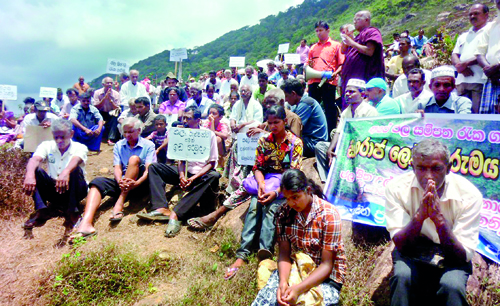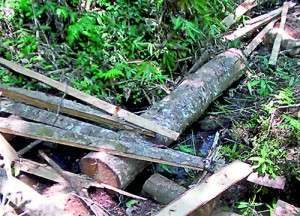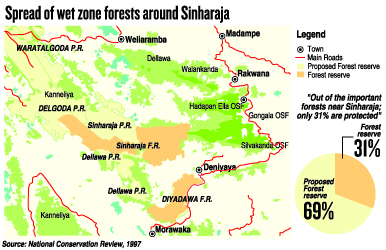News
Chop, chop – and our rivers die, farmers starve and elephants are lost
Relentless deforestation of the Sinharaja by private interests has brought drought to the farming hamlets of the area and threatens the survival of the remaining Sinharaja elephants whose last hideout is vanishing – and the government says it is helpless.
For centuries the springs and streams of the Sinharaja Forest have flowed into the fields of the villages that dot the area, blessing farmers with good crops and providing drinking water even at height of droughts. But now the waters are drying up.

Protestors hold placards. Pix by Lasantha Niroshana
As villagers demand protection for their water sources, alarmed ecologists such as Dr Suranjan Fernando stress the need to follow the National Conservation Review (NCR) recommendations to keep the country’s water cycle in balance.The water shortage in Rakwana in the Sinharaja, villagers say, is due to the cutting down of the forest in Pannila Kanda, a small hill covered by forests. The community-based water projects based on the water coming down through the streams of Pannila Kanda are failing because, residents say, tree-felling has dried up the springs. Several hundreds of villagers from at least 10 hamlets joined a protest held last month at the height of the drought, demanding to protect the forest in Pannila Kanda. They had known about the tree-felling for some time but decided to take protest action when all the pleas for help fell on deaf ears.
Talking to the Sunday Times, the Ven. Ammpitiye Vijitha Thera who led the protest, said the forest clearance appeared to have temporarily stopped after the protest, but he urged the authorities to provide firm protection of the villages’ water sources.The

Felled trees
natural springs in this forest have never gone dry even at height of droughts in the past, recalls Ammaduwa Damma Thero, who has lived in the village for more than 35 years.
The Conservator-General of Forests, Anura Sathurusinghe, says the cutting down of this precious forest is being carried out on privately-owned land and his hands are tied. The owners clear the forest to plant tea and other economic crops and the authorities could not do anything as they have legal deeds for the land. Rakwana Divisional Secretary B.S. Ruwansiri, also confirmed that the area being cleared is private land of an extent of about 160 acres owned by three people.
As clearance of more than one hectare of land needs permission granted after an environmental evaluation the Central Environment Authority (CEA) has begun a study to review the impact of forest clearance of Pannila Kanda, the Divisional Secretary said.This area is also a last hideout of three Sinharaja elephants, and those who visit the area found fresh droppings, indicating the importance of the forest for the survival of these jumbos. These areas are very rich in biodiversity.
Experts point out the need to adhere to the recommendations of the National Conservation Review (NCR) which highlight the importance of forests, not only for biodiversity but also for watershed functions and soil conservation.
The report is a comprehensive assessment, of forests more than 200ha in area in all areas except the North and East. This comprehensive study, which ended in 1997, shows that many of the most important forests for soil and water conservation are not protected.
As a result, 281 forests have been identified for watershed protection, 85 as being extremely important for soil protection and flood control or interception of fog in the case of those located above 1500m.
The report stressed that the remaining Wet Zone forests such as Pannila Kanda are a top priority for soil and water conservation, particularly the largest units of contiguous forest in Central Highlands, the Kanneliya complex, the Knuckles and Sinharaja, which also protect the headwaters of the country’s major rivers.The report recommends the declaration of six clusters of forests not only for their biodiversity but also for the forests’ watershed facilities and flood control. The forests in the Wet Zone are particularly marked for protection because of their watershed capabilities.Besides this, areas such as Pannila Kanda, an isolated hill in this biodiversity-rich area have the potential of harbouring new and undiscovered species of small creatures which have evolved in isolation over centuries.The NCR recommendations, completed in 1997 and handed over to the Forest Department, have not been released according to those who followed the proceedings. Thus these important recommendations have gone unconsidered even in designing the Sri Lanka Physical Plan – the blueprint for the allocation of land for development.The Conservator of Forests, Mr. Sathurusinghe, said the Forest Department was implementing the NCR recommendations but he acknowledged that matters were moving slowly.
| Water, not fuel, will determine the future: Minister
The conservation of water sources should be the primary development priority for Sri Lanka rather than building expressways or ports, said the Minister of Science and Technology, Professor Tissa Vitharana, delivering the Earth Day message at an event organised at the National Science Foundation (NSF) last month.In a future threatened by climate change the importance of water will be more than that of fuel, he said, citing the latest report by the Intergovernmental Panel of Climate Change (IPCC). The report says there will be significant variations in rainfall, and countries like Sri Lanka will face huge water shortages in prolonged droughts. Climate adaptation will become vital for survival and the functions of forests will, the report says, be crucial for water supply.Natural forests play an important role in conserving soil and water resources in many ways. They contribute to the stability of watersheds by protecting the soil surface from the direct impact of intensive tropical rainstorms, by stabilising ground water levels and stream flows, and by recycling rainfall as part of the hydrological cycle. Rainfall is intercepted by the forest canopy, and when it falls on the forest floor protection from splash erosion is provided by the covering of leaf litter.The removal of forest cover exposes the soil to erosion and compaction, emphasises The National Conservation Review (NCR). Reduced vegetation cover allows more water to reach the soil more rapidly. Less infiltration, caused by surface sealing and compaction, increases surface run-off and hence erosion, resulting a quick reduction of the depth of the soil and its capacity to store water.With increasing surface run-off the groundwater table is progressively lowered and processes of desertification set in. Steep hillsides become more prone to landslides as tree-roots rot, perennial streams become intermittent and floods more frequent, with increased surface run-off and accumulating sediment in the riverbeds.Inevitably the repercussions of increased sediment loads and higher flood peaks are experienced further downstream from the deforested headwaters. In the long term, sedimentation of reservoirs could substantially reduce their capacity to store water for hydropower and irrigation, jeopardising the agro-industrial base of the economy, the NCR report says. |

